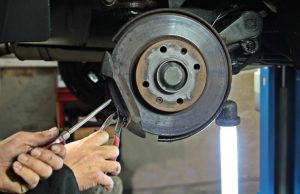If you give it some thought, brakes are an amazing and important invention. Read on to discover how do car brakes work here.

The first thing new drivers are taught when they get into the driver’s seat is where the brake is. Knowing how to stop the car is the most essential skill to have before you get out on the road. What a lot of drivers don’t ask though is just how do car brakes work?Keep reading to find out just how modern brakes work and why they’re so much more effective than ever before.
How Do Car Brakes Work? Any driver can tell you how brakes work. You stomp on the pedal and your car comes to a stop. Easy, right?Not so much. When you push down on that pedal a complex hydraulic system springs into action.
The brake pedal is connected to something in your car called a master cylinder. This contains the brake fluid and converts the force of your foot pushing on the brake pedal into pressure that’s applied to the individual brakes.
Each of the tires on your car has another hydraulic cylinder called a slave cylinder. Poor choice of words, but it does explain how they work. When the master cylinder puts pressure on the system the individual slave cylinders likewise pressurize and cause the brakes to engage.
The basic mechanical parts of a brake are the pads and rotors. When you hit the brake pedal the pad is pressed firmly against the rotor and uses friction to convert the kinetic energy of the wheel into thermal energy in the form of heat.
For automobiles, there are two major categories of brakes, drum brakes, and disc brakes. Check out the performance disk brakes on this 1968 Chevy Camaro
Drum Brakes
Drum brakes have been around as long as cars have been used. They use a pair of shoes or pads that press up against the wheel and slow down your car.
They’re inexpensive and provide significant corrosion protection since they run on a closed system. The downside to the drum brake design goes back to how brakes work.
As drum brakes are used they rapidly produce heat. Because they’re a closed system they don’t radiate this heat away very efficiently. If you’ve ever heard the term brake fade, it was probably about drum brakes.
Because of this most modern cars are switching to disc brakes.
Disc Brakes
Disc brakes are superior to drum brakes in just about every respect. They rely on a system of calipers that press a brake pad against a spinning rotor.
The pad and the rotor are both open to the air, allowing significantly faster cooling. Their design also allows for a much more responsive braking system.
The design of drum brakes causes them to bite down pretty hard when braking pressure is applied. With disc brakes, you can precisely control how much you want to slow your vehicle.
Basically every kind of performance brake rotor is going to be a disc brake.
Modern Braking Systems
Modern brakes use hydraulic pressure to convert kinetic energy into heat. As this heat radiates away your car slows down. If you’ve got a performance car you should absolutely use disc brakes rather than drum brakes. You’re ready to tell all your friends if any of them ask how do car brakes work.
If you found this educational and interesting you should check out some of our other great automobile articles to learn more about how your car works.










